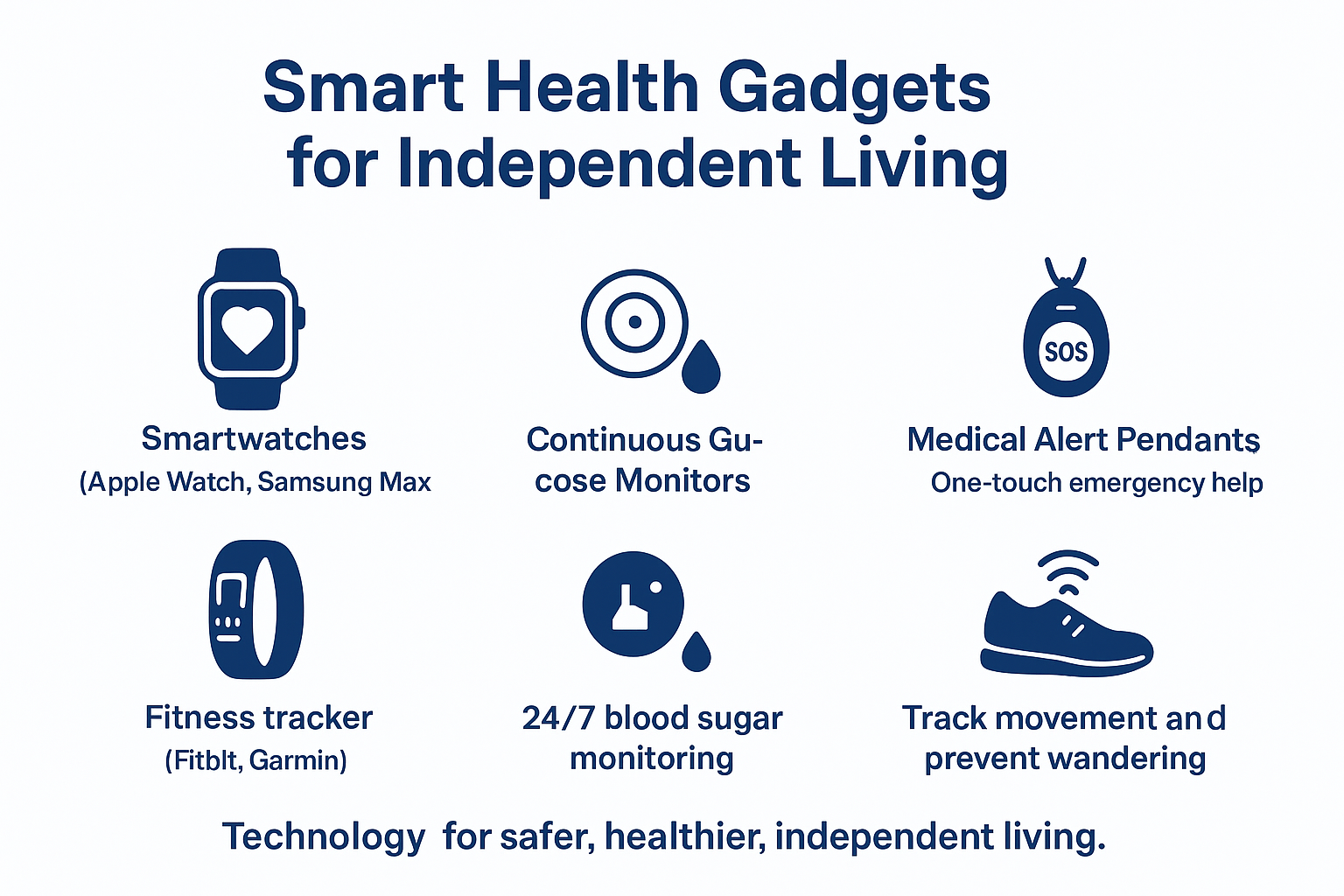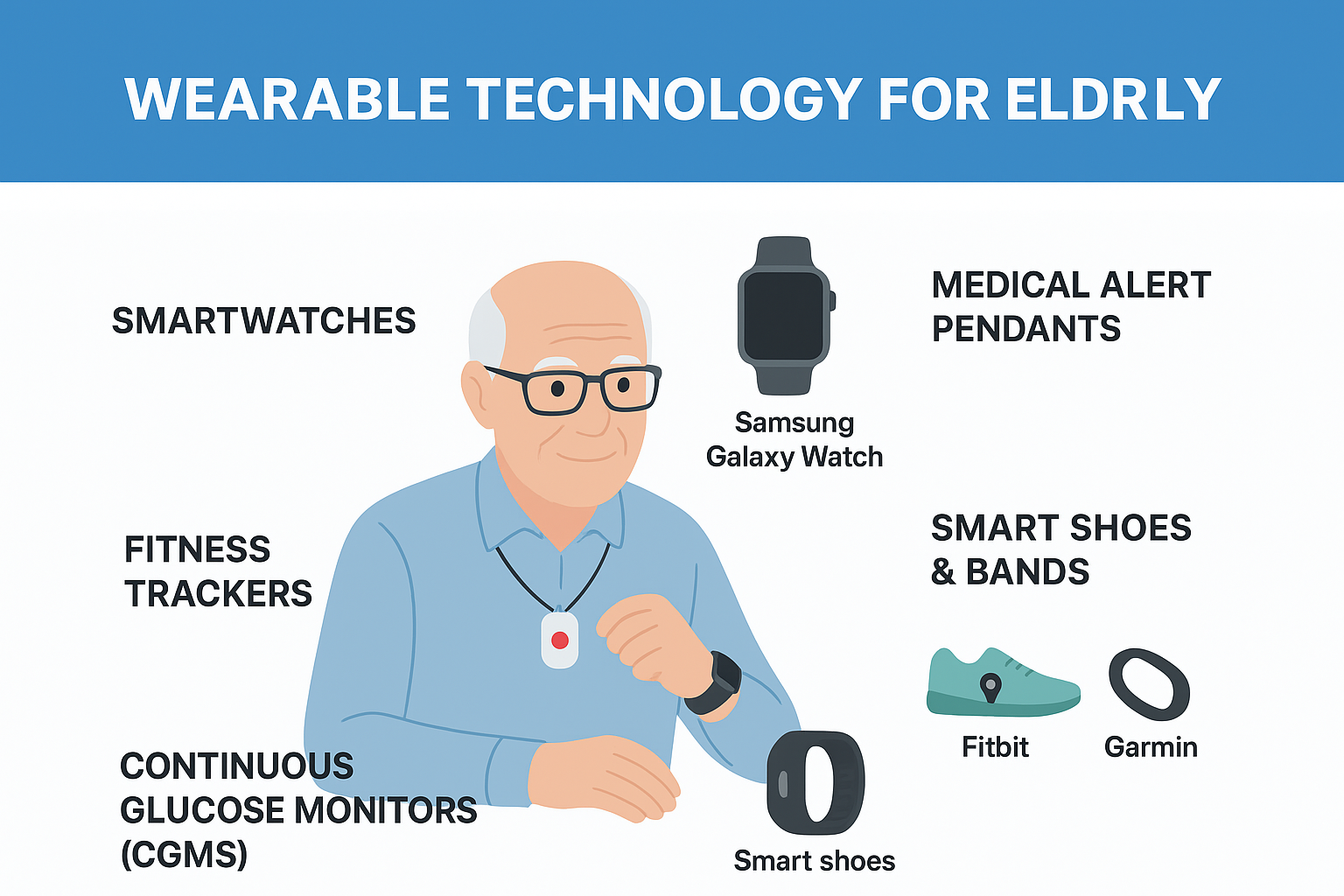Imagine having the reassurance that your loved one is safe, even when you’re not around.
Today, wearable technology for the elderly provides smart devices that track health, detect falls or emergencies, and keep families connected. These innovative tools offer peace of mind while helping seniors live safely, independently, and with confidence.
Nowadays, seniors want to stay active, independent, and connected. Therefore, Wearables bridge that gap by blending health monitoring with everyday comfort.
To understand their impact better, let’s explore what wearable technology for the elderly really means.
What Is Wearable Technology for the Elderly ?
Simply put, wearable technology for the seniors refers to smart devices worn on the body, such as watches, pendants, or bands, that track and share health or safety data.
For the elderly, these devices can:
- Monitor heart rate and blood pressure
- Detect falls and send alerts
- Track sleep and activity levels
- Remind about medications
- Provide GPS tracking for safety
Also Read
Is Anxiety a Disability? Understanding the Legal, Medical, and Practical Side
Benefits of Wearable Technology for the Seniors
1. Safety and Emergency Alerts
Fall detection watches and pendants can automatically call family or emergency services. As a result, seniors can receive help quickly.
2. Better Health Monitoring
Moreover, Real-time tracking of blood sugar, heart rhythm, or oxygen keeps seniors and doctors updated.
3. Independence with Confidence
In addition, Elderly individuals can live alone while families stay reassured through connected apps.
4. Medication Reminders
Furthermore, Smartwatches can buzz or display reminders, reducing missed doses.
5. Social Connection
Finally, Some wearables include voice calls and messaging, reducing loneliness.
Types of Wearable Technologies for the Seniors
Wearable technology for the elderly includes many smart and easy-to-use devices designed for safety and health monitoring.
- Smartwatches like the Apple Watch and Samsung Galaxy Watch offer fall detection, heart rate sensors, and activity tracking. In an emergency, they can alert family members or emergency services right away.
- Medical Alert Pendants, such as Life Alert or Bay Alarm Medical, provide one-button access to help. Additionally, their built-in GPS makes it easy to locate the wearer during emergencies.
- Fitness Trackers like Fitbit and Garmin monitor daily steps, sleep, and heart rate. As a result, they encourage seniors to stay active and healthy.
- Smart Shoes and Bands with GPS tracking can help locate dementia patients who wander. This feature gives caregivers peace of mind and enhances safety.
- Continuous Glucose Monitors (CGMs) measure blood sugar automatically. Therefore, seniors can track their glucose levels without frequent finger pricks.
Real-Life Example
For instance, Mary, age 72, relies on a smartwatch with fall detection. One evening, she slipped in her kitchen. The watch quickly sent an alert to her daughter’s phone and to emergency services. Consequently, Mary received timely help, demonstrating how wearable technology can truly be life-saving. Despite such benefits, there are still challenges to consider.
Challenges and Considerations
However, there are still challenges to consider:
- Ease of use: Devices must be simple, with large displays and voice prompts.
- Battery life: Long-lasting batteries matter for seniors.
- Affordability: Cost can be a barrier for fixed-income retirees.
- Privacy: Clear data protection policies are important for trust.
Future of Wearable Technology for Seniors
Looking ahead, the future of wearable technology for seniors holds even more promise.
- AI-driven fall prediction (detecting risks before they happen).
- New wearables will monitor hydration and nutrition.
- Seamless integration with telehealth platforms.
- Moreover, more stylish, comfortable designs seniors enjoy wearing.
Conclusion
In Conclusion, Wearable technology for the elderly is not just about gadgets — it’s about dignity, safety, and independence. Ultimately these devices empower seniors to live healthier, freer lives while giving families peace of mind. If you’re considering wearable technology, here’s how to get started.
👉 If you have elderly loved ones, consider starting with a simple smartwatch or medical alert pendant. After all, It can provide crucial support when every moment is important.
FAQs
Q1. What is wearable technology for the elderly?
A. It includes smartwatches, pendants, and trackers that monitor health, detect emergencies, and improve safety for seniors.
Q2. How does wearable technology help elderly people?
A. It provides health monitoring, fall detection, medication reminders, and GPS tracking for safety and independence.
Q3. Which wearable devices are best for seniors?
A. Popular choices include Apple Watch, Fitbit, Life Alert pendants, and continuous glucose monitors for diabetic patients.
Q4. Are wearable devices easy for seniors to use?
A. Yes, many are designed with simple screens, large icons, and voice assistance to make them senior-friendly.
Q5. What is the future of wearables for the elderly?
A. The future includes AI-based fall prevention, non-invasive health checks, and integration with telemedicine.

